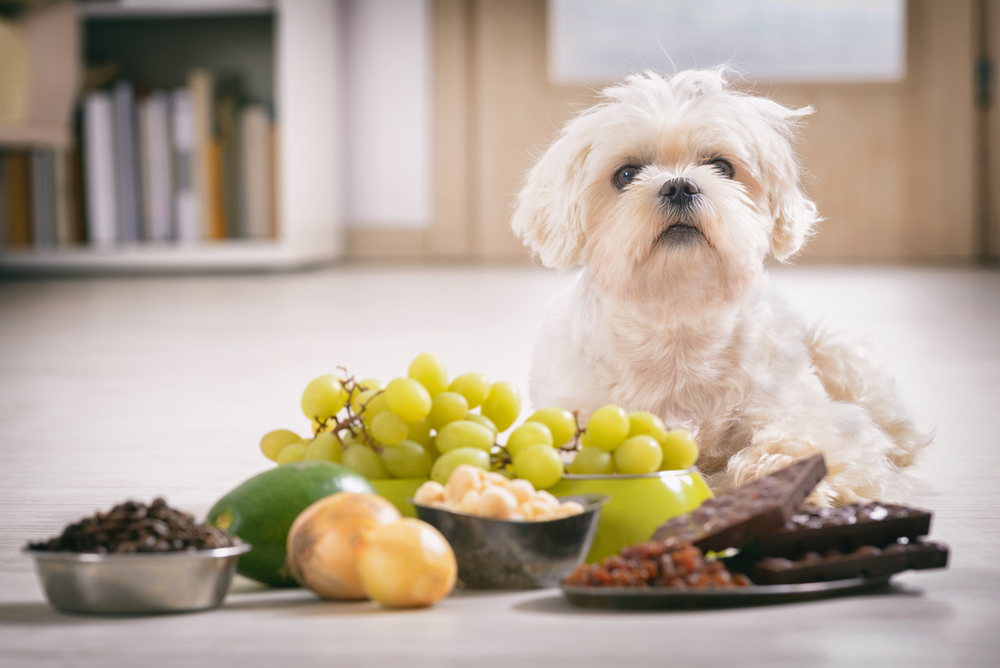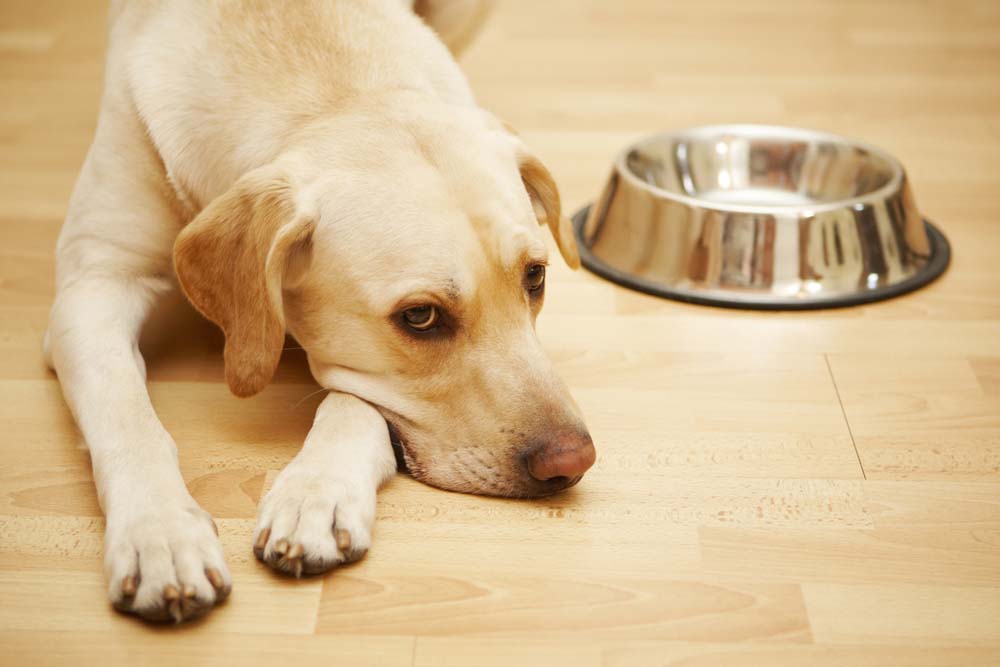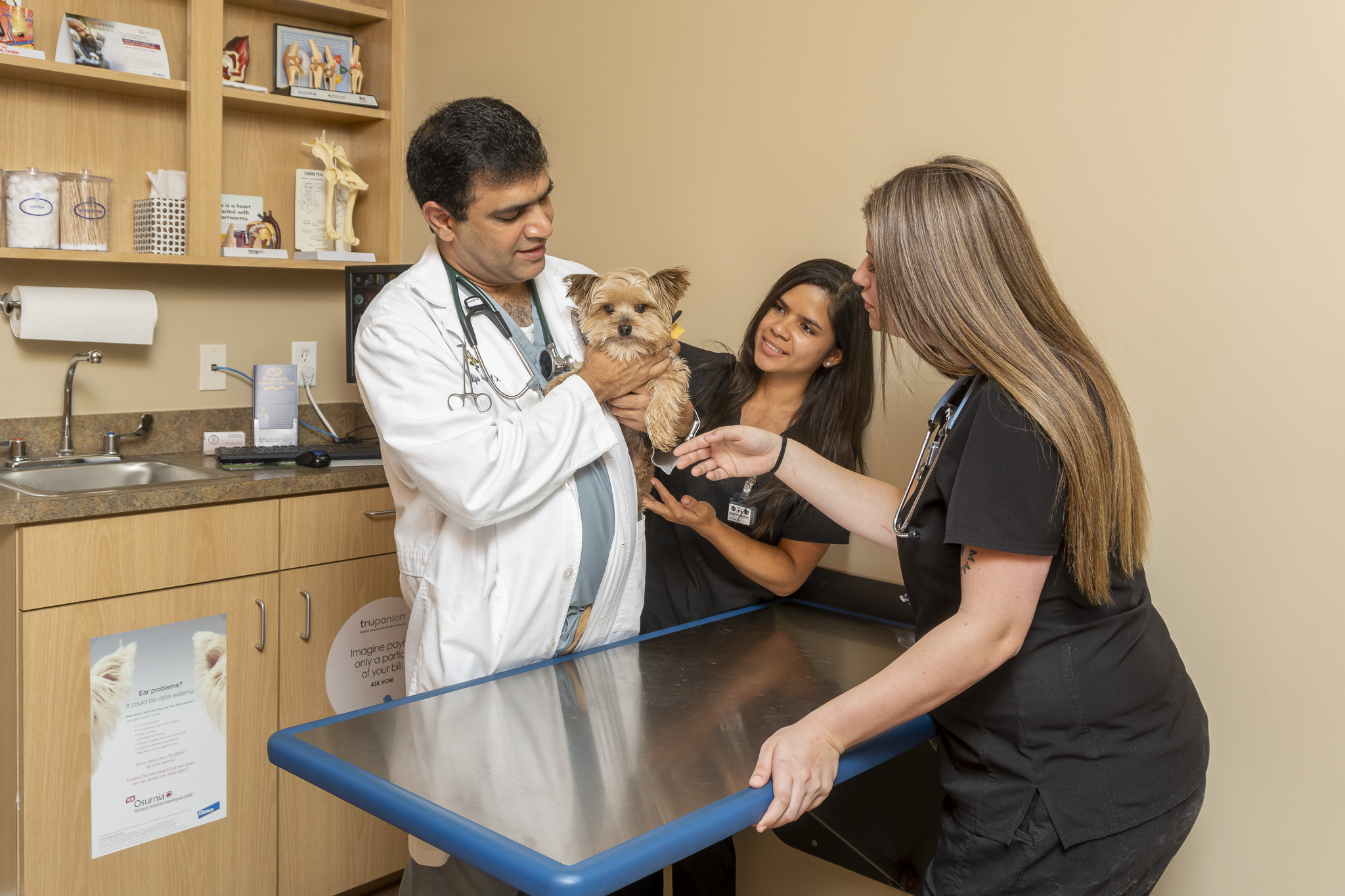
We're here for you
Emergency?
If your pet is exhibiting concerning symptoms or experiencing a medical emergency, please call our clinic at (407) 352-2579. We’ll help you through it.
Pets are curious creatures. If they smell something that’s cooking in the kitchen or see some food dropped on the ground, they will want to take a bite and see what it is for themselves. However, not all human food should be given to pets, even if they try their hardest to get them from us. To keep your pet healthy, it’s important to know what foods are off-limits for them so you can avoid an emergency trip to the vet. Here are some common foods that you shouldn’t feed to your pet.

Foods To Avoid Feeding Your Pet
If you notice that your pet has consumed any of the following foods, even in a small amount, you may want to seek advice from your vet. In large amounts, these foods can be life-threatening and your pet could need emergency treatment.
Chives, Onion, Garlic
All a part of the allium plant family, these foods can cause anemia in dogs and cats. Onions, garlic, and chives contain sulfoxides that can damage the red blood cells in their systems. In some cases, consumption can lead to death. These herbs and plants can enhance our cooking and are used frequently in many recipes, but they can cause harm to our furry family members. Therefore, it is important to stay alert and keep any food cooked with allium plants away from our pets.
Signs Your Pet Has Eaten Chives, Onion, or Garlic
Large amounts of allium plants can cause severe symptoms in dogs and cats, including:
- Pale gums
- Diarrhea
- Drooling
- Vomiting
- Decreased appetite
- Increased heartrate
Bones
Outdoor cats may already be regularly eating raw meat and bones because of their instinctive hunting habits. While it’s natural for them to eat what they hunt, bones could be a choking hazard if your cat doesn’t chew properly. The smaller the bones, the harder they are to chew and therefore the greater the choking hazard they present. You may want to consider keeping your cat indoors or, if you choose to feed your dog or cat raw meat, making sure that there are no small bones in it.
Signs Your Pet Has Eaten Bones
If your pet has eaten raw meat and is choking on the bones, key signs to look out for are:
- Trouble breathing
- Pacing
- Discolored gums
- Coughing or gagging
Caffeine
Coffee grounds or tea leaves can easily be sniffed and consumed, especially if you have accidentally dropped them on the ground where your pet can reach. Coffee and tea should not be given to your pets to eat because of the methylxanthines found in caffeine. Substances with methylxanthines can cause irregular heartbeats, vomiting, or even seizures in dogs and cats if consumed.
Signs Your Pet Has Consumed Caffeine
Just like humans, drinking beverages containing caffeine can cause similar symptoms in pets such as:
- Hyperactivity
- Panting
- Vomiting
- Excessive thirst
Nuts
Nuts like macadamia nuts, pistachios, or almonds can lead to an upset stomach in pets. The high-fat content is difficult for most pets to digest and can cause inflammation of the pancreas, vomiting, and whole-body weakness. They can also be a choking hazard for animals being so small and often having brittle outside shells that can easily get stuck in a pet’s throat.
Signs Your Pet Has Eaten Nuts
After eating nuts, your pet may show symptoms including:
- Seizures
- Weakness
- Vomiting
- Shivering
Grapes and Raisins
The tannins and flavonoids in grapes are usually what cause the most trouble for pets, especially dogs. Most pets are unable to metabolize the tannins and this can lead to kidney failure or even death. So if you enjoy eating grapes or raisins, stay alert and keep them away from your pets to avoid causing them uncomfortable symptoms like loss of appetite or the inability to pass urine.
Signs Your Pet Has Eaten Grapes or Raisins
Since grapes can be harmful to dogs, stay alert and watch for these signs of consumption:
- Increased thirst
- Diarrhea
- Lethargy
- Vomiting
Chocolate
Chocolate or cacao-containing products are known to be trouble for animals. The theobromine that exists in chocolate can cause seizures, hyperactivity, diarrhea, or vomiting. The darker the chocolate and the higher the concentration of cacao means an increase in lethal theobromine. While we can digest theobromine without issues, for dogs and cats it is off-limits.
Signs Your Pet Has Eaten Chocolate
High levels of cacao can be dangerous for pets. If you think your pet has eaten chocolate, be attentive and watch for these symptoms:
- Restlessness
- Increased heart rate
- Increased urination
- Vomiting
- Muscle tremors
Fruit Pits
Fruits that contain pits like plums, apples, or apricots should never be given to pets. The cyanide that exists in fruit pits can lead to severe symptoms like a fast heartbeat, vomiting, and in extreme cases death. The cyanide can make it difficult for pets to get adequate oxygen to their cells. While dogs can typically eat apples without any issues, the pits inside the apples should not be given to pets for consumption.
Signs Your Pet Has a Fruit Pit
Look out for these symptoms if your pet has consumed the pit of a fruit:
- Bright red gums
- Abdominal pain
- Trouble breathing
- Dilated pupils
Alcohol
Alcohol consumption can be toxic for pets. The typical amount that humans drink would be unsafe for animals, especially given their smaller body weight. Animals may be increasingly fascinated by the smell of sweet alcoholic drinks and try to taste it, but if they consume too much they could get alcohol poisoning. Even a small taste of alcohol could cause your pet to have low blood pressure or an irregular heartbeat. Severe cases of alcohol poisoning in pets will lead to vomiting or trouble breathing.
Signs Your Pet Has Consumed Alcohol
Similar to the symptoms of alcohol poisoning in humans, pets may also show symptoms such as:
- Vomiting
- Respiratory failure
- Increased urination
- Increased thirst
- Lower body temperature
How Much of These Foods Can Pets Eat?
When consumed in small quantities, some of these foods may have no effect on your pet. For instance, while chocolate is extremely toxic for dogs, a small piece of milk chocolate may not produce any obvious symptoms. The key factors to consider whether or not your pet is in danger are the quantity, concentration, and size of your pet. The smaller the pet and the higher the quantity consumed, the more likely they could be at risk of becoming severely ill or dying.
For example, a dog might start to experience negative side effects after eating 9 mg of chocolate per pound of body weight.
What To Do If Your Pet Eats Something They Shouldn’t

If your pet accidentally eats something they shouldn’t, stay calm and contact a professional. You may be able to treat your pet at home following your vet’s instructions, depending on how much your pet has eaten. If they’ve consumed a large quantity of toxic food, you’ll most likely need to take them to the vet for emergency treatment.
Call Animal Poison Control
The first thing you should do if your pet eats something harmful is always to call animal poison control. Over the phone, the animal poison control center will ask you investigative questions to get a better understanding of the severity of the case and walk you through any necessary next steps.
Get a Consultation From a Vet
After calling animal poison control, get the soonest available appointment with a vet. A vet can give your animal a professional consultation and provide any necessary testing or treatment. If your own vet doesn’t have emergency after-hours service, other vets may.
Common Treatments for Pets After Consuming Toxic Substances
A vet may follow some of these treatments to help your pet after they eat something they shouldn’t.
- Fluid IV
- Inducing Vomiting
- Activated Charcoal
Store Unsafe Products Away From Pets
For future prevention, store any of the listed unsafe products away from your pets. If you keep these items out of reach, you can reduce the risk of animal fatality. If and when you decide to consume things like chocolate or alcohol yourself, stay on high alert to ensure that your pet doesn’t try to take some for themselves. Active awareness and prevention could save your pet’s life.

Step One:
Call us to book your pet’s appointment.

Step Two:
Our expert vet will take care of all of your pet’s needs.

Step Three:
Get back to enjoying your happy and healthy life with your furry best friend.

Get the Best Care for Your Pet
Come Visit Dr. Qasim
Book your pet’s appointment with Dr. Qasim to ensure a long, happy life together.


We love and care for each patient as if they were our own pet.
Meet Our Team of Animal Lovers
Dr. Bilal Qasim, DVM, established Dr. Phillips Animal Hospital in 2011 after practicing veterinary medicine for over 17 years with the help of talented and caring veterinary technicians.


